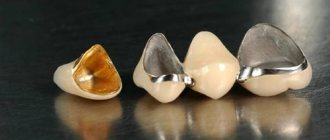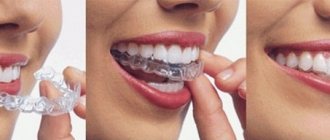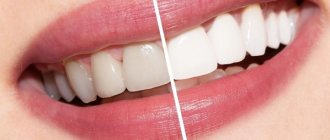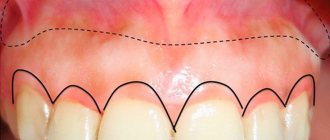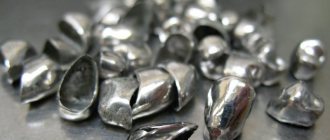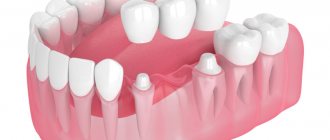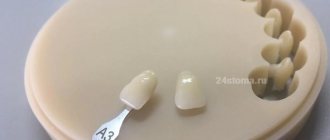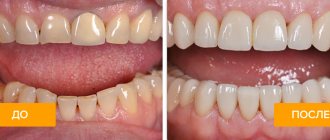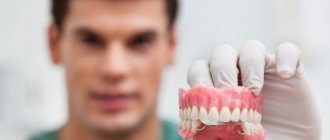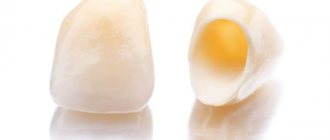Tooth preparation is a dental procedure that involves removing (grinding) surface dental tissues and giving the dental crown a shape that would allow it to be easily covered with a prosthesis.
Until recently, teeth grinding was considered one of the most unpleasant and painful dental procedures. In modern medical practice, dissection is performed under local anesthesia using high-tech equipment to minimize discomfort from the procedure.
What is tooth preparation
As part of the procedure, the specialist grinds down the hard tissues of the tooth in order to achieve a flat and smooth surface suitable for fixing a crown or orthopedic structure. Only the tightest possible contact between living and artificial tissue provides reliable protection of the enamel from injury, and also guarantees the strength of the product’s fixation.
In addition, the tooth is given a certain shape that exactly replicates the internal cavity of the crown. This allows you to fix the prosthesis more tightly and accurately.
Tooth preparation
If earlier this procedure was quite lengthy and quite painful, now before it is performed the patient is given an injection with an effective local anesthetic. Modern methods of pain relief guarantee absolute painlessness and a high level of comfort for the patient.
Turning methods
- tunnel turning: the classic use of a drill using a metal or diamond tip. The device operates in various speed modes, but at very high speeds, so to prevent overheating of the tissues, a stream of cold water must be supplied. The technique allows grinding down any amount of living tooth tissue,
- ultrasound: this method involves the use of a special device that transmits high-frequency vibrations. In this case, the instrument does not come into direct contact with the enamel, thereby reducing the risk of injury to dentin and nerves. The procedure is completely painless and safe, but allows for the preparation of only a small amount of dental tissue,
- laser: the procedure does not pose any threat to health and allows you to achieve the desired result in the shortest possible time. This method refers to non-contact methods of grinding teeth, so the risk of damage to the pulp is minimized. True, it is also used when removing small amounts of dental tissue,
- air-abrasive preparation technique: the method involves exposure to water with a mixture of abrasive particles, as a result of which hard tissue is ground down to the desired shape and size. In this case, the patient does not experience pain. This method allows you to preserve as much healthy tissue as possible, and also eliminate the risk of chips and cracks after turning,
- chemical method: here they use acids that can quickly and reliably destroy hard tissue. After exposure to the composition, the specialist removes the softened areas and creates the desired shape. This is a rather lengthy procedure, and also very outdated.
When is the preparation performed?
Currently, there are several main types of dental preparation, depending on the type of structure that is planned to be installed to restore the aesthetics and functionality of the dentition:
- veneers: surface treatment for veneers is carried out using a special technology. At the first stage, the specialist works on the front side, after which he gradually moves on to the side surfaces. Only in rare cases is it necessary to prepare the anterior teeth in the palatal area or the incisal edge. As a rule, horizontal and vertical groove stripes are created on the enamel, in which dental glue will be located,
- inlays: partial dentures that are used to hide minor defects. In order to securely fix such a product, the side walls are prepared parallel to each other1. This form makes it possible to easily and quickly install the structure at the required depth,
- crowns and bridges: a crown is an artificial top that protects the tooth from the development of carious lesions, prevents infection of weakened tissues, and also allows you to restore aesthetics to your smile and restore full functionality. Grinding is required for metal-ceramic crowns, cast metal, porcelain, zirconium, ceramic and plastic solutions, as well as for bridges, except for adhesive bridges - their installation does not require additional grinding of some tissues,
- splinting: this procedure involves fixing mobile teeth in the correct position using pin, beam or inlay splints. In this case, it is necessary to remove a minimum amount of enamel, but in some situations depulpation may also be required.
“Relatively recently, I went through all the stages of installing metal-ceramic crowns, including preparation. During the procedure I did not feel any pain at all. The doctor gave an injection of anesthesia in advance, so everything went well.
But the sensations themselves are of course very unpleasant, and then there’s this terrible roar of the boron! I still don’t know whether this was a medical error, but after grinding my dead tooth suddenly turned pink! In general, I was given temporary crowns first, and then metal-ceramics.
I really hope they last a long time!”
Marina, 47 years old, from correspondence on a thematic forum
Complications and pain after turning
If the quality of the procedure is poor, there is a risk that the patient’s tooth cavity will subsequently open.
Even if the preparation was carried out as carefully as possible, the pulp is in any case subjected to a certain impact, as a result of which the vessels dilate and swelling occurs.
Immediately after grinding, no pain is felt, however, when the effect of the painkiller wears off, discomfort appears and the gums become inflamed.
According to practicing experts in the field of prosthetics, if a vital tooth was subjected to preparation, that is, with the pulp not removed, above which only a thin layer of dentin remained, then after turning the tooth will react to the cold and cause some discomfort. Therefore, specialists resort to temporary structures or cement the worn-out area until a permanent solution is installed.
Sometimes during the procedure, the doctor has to slightly push back the gums using a special thread, which entails compression of the soft tissues and provokes the development of swelling and pain.
What to do if your gums hurt after grinding? As a rule, the discomfort goes away on its own after a few days. In this case, the doctor can immediately suggest the best way to rinse your teeth after grinding in order to relieve acute symptoms.
If quite a lot of time has passed after the procedure, but your teeth still hurt, you should seek help from a specialist.
Pushing back gums with floss
Types of ledges
Grinding of teeth is carried out strictly according to certain rules, with short breaks (to prevent tissue overheating). Immediately after the procedure, temporary crowns or fillings are installed on the treated living teeth. During the preparation process, a specialist can form the following types of ledges:
- knife-shaped: the widest of all, therefore suitable for crowns that have a thick layer of tissue, namely all-metal or metal-ceramic crowns,
- grooved: the rounded shape in this case makes it possible to preserve the maximum volume of living tissue. The width can vary from 0.8 to 1.2 mm. This option is ideal for metal ceramics,
- humeral: this type of ledge with a width of 2 mm requires depulpation. However, this option can significantly increase the strength of the crown fixation and provide higher aesthetic characteristics2.
Features of the procedure in childhood
When working with baby teeth, dentists try to avoid unnecessary procedures that may pose a certain threat to the condition of the child’s thin enamel. In addition, any additional manipulation using a noisy drill usually results in serious stress for the child.
As a rule, experts offer alternative and more gentle treatment methods that do not require preliminary preparation.
In this case, pediatric dentistry is focused on protecting the not yet fully formed enamel from any type of injury. However, there are situations when turning for a crown is indispensable.
Most often, preference is given to the chemical method, as it is less painful. Usually it is enough to remove only the tissue affected by caries.
Without turning - alternative methods of prosthetics
- removable prosthetics: the most cost-effective and fastest option for restoring the integrity of the dentition. In this case, the structure can be fixed using a special fastening system on the supporting teeth or even in the absence of all of them in the oral cavity. In this case, no turning of supporting elements is required,
- conditionally removable prosthetics: in this case, tooth roots are used to fix the system, which must be in excellent condition. During the installation of the prosthesis, they are strengthened using special pins with a small lock. When installing the prosthesis, the lock automatically snaps into place and the system is securely held in the mouth,
Clasp dentures with locks - adhesive bridge: to fix such a structure, the presence of two supporting elements is necessary, but they are not subject to preparation. Along the edges of one or more artificial crowns there are special plates that allow you to fix the system by attaching it from the inside using dental glue,
- implantation: this treatment method involves replacing not only the crown, but also the root, which allows you to restore the anatomy and return the full functionality of the entire dental system. In this case, the implant, which acts as a root, is installed inside the bone tissue, and then a crown or any other orthopedic structure is put on it.
Types of ledges during preparation
Preparation of teeth with a ledge is a prerequisite for reliable fixation of the prosthetic structure in the oral cavity.
The most common methods of grinding teeth with a ledge:
- Knife -edge . The most commonly used type. Its width is only 0.3-0.4 mm. This is the best option for preparing inclined teeth and for solid metal crowns.
- Rounded grooved ledge ( Chamfer) . With a width of 0.8-1.2 mm, it allows maximum preservation of dental tissue. It is a classic option for metal-ceramic prosthetics.
- Shoulder ledge . The most uneconomical type with a width of 2 mm, requiring depulpation. However, it has the highest aesthetic characteristics and allows the crowns to be secured most firmly.
Grinding teeth without a shoulder is a serious mistake by the dentist, since the prosthetic crown will not be able to fit tightly to the tooth surface. And this will greatly complicate the care of dentures and increase the risk of developing caries.
Is it painful to grind teeth for crowns?
It is impossible to perform prosthetics without special preparation of teeth, which consists of grinding them down. It is used to level the surface of hard tissues. Many patients find this stage of prosthetics the most unpleasant due to the possible pain of the procedure. The following describes in detail the features of turning.
Necessity of the procedure
No person's teeth are perfectly shaped. The bulges present on them interfere with the production of comfortable crowns. Therefore, the dentist has to prepare or, as people say, grind the teeth.
The preparation stage is necessary to ensure that the manufactured dentures have the correct shape, fit well to the teeth and are firmly attached to them.
The tooth must be prepared by an experienced doctor, who will do this taking into account the thickness of the crown being installed. After all, the manufactured prosthesis should not interfere with talking and chewing food.
Grinding a tooth is often also a therapeutic procedure that removes tissue affected by caries. This stops the progression of the disease
Preparation methods
There are several methods used for preparing (grinding) teeth:
- Ultrasonic
- Using laser
- Chemical
- Tunnel
- Using an air abrasive device
An ultrasound machine performs grinding using waves that do not damage soft tissues or cause overheating of hard tooth tissues.
The amount of heat generated when exposed to ultrasound is minimal. The vibration of the device is low, so cracks do not occur during turning.
The procedure using this method is painless.
Preparation of tooth tissue for subsequent prosthetics using a laser does not cause discomfort or pain.
The advantages of the laser method include speed, noiselessness, safety and the absence of mechanical impact on the nerve endings, which irritates them
The ability of a laser to destroy pathogenic microflora makes additional treatment of the oral cavity with antiseptic solutions unnecessary.
The chemical preparation method takes longer. Special substances soften enamel and dentin. The use of anesthetics is not required, there is no heating of the tooth tissue, and there are no chips or cracks on its surface.
During air-abrasive grinding, sandblasting of hard tooth tissues is performed. Sodium bicarbonate and aluminum oxide serve as abrasives in this case. They are fed through the tip of a special apparatus onto the tooth and grind down the required amount of hard tissue without overheating it and maintaining its sufficient volume. The method is painless.
A turbine unit is used for tunnel turning. The speed of its operation is adjustable. Preparation is carried out with a diamond or metal tip
The classic method is the most painful and unsafe compared to the others.
Along with modern methods, the classic one is still used - grinding the tooth under a crown using a drill. This method is the most painful and unsafe compared to the others.
Unpleasant consequences can be a crack in the enamel or damaged gums.
But during such preparation, the doctor can control the volume of enamel removed, which is an advantage of this method.
It is necessary to choose a preparation method depending on the condition and structural features of the teeth of a particular patient.
He, for his part, before performing prosthetics, must familiarize himself with the technical equipment of the clinic and all the features of the procedure.
Features of teeth grinding
Before starting the preparation, the doctor usually takes an x-ray to clarify the characteristics of the pulp and its reaction to medications, the structure of the tooth, and also determine its condition.
If the nerves of the tooth are killed, then there is no need for anesthesia before preparation using the classical method.
Different types and materials of crowns require different grinding features.
For example, for metal-ceramics, the tooth is ground on all sides, for metal crowns - on the sides, so as not to injure adjacent units.
To install a zirconium crown, the tooth is ground to form a rounded shoulder. If the crown is made of porcelain, the tooth is given a cylindrical or conical shape.
If anesthesia before preparation was performed correctly, the patient does not experience pain during the procedure. It can only occur when a significant layer of dentin is removed or when soft tissue is compressed.
Features of preparation in children
Preparation of primary primary teeth in children is a serious problem in dentistry. Young patients are the most difficult group among dental office visitors due to the high prevalence of phobia of the sound and sight of a rotating drill. In addition, baby teeth have a number of anatomical features that do not allow “adult” manipulations.
Therefore, doctors are looking for alternative methods for preparing teeth for caries in childhood.
The most promising method in this case is considered to be chemical preparation, which does not cause negative sensations even in the smallest children, but at the same time allows for sufficient quality treatment of the carious cavity.
Does it hurt to put crowns on your teeth?
Almost all patients faced with the need to install a crown are interested in the question of whether the process of prosthetics involves pain and other discomfort. Unfortunately, almost all dental procedures are quite painful, so most of them are performed under local anesthesia.
Whether it hurts to put a crown on a tooth depends on the professionalism of the dentist himself and the characteristics of the body (sensitivity threshold) of the patient himself. As a rule, unpleasant sensations can arise exclusively during the preparatory stage of prosthetics, which includes:
- removal of the dental nerve;
- depulpation, cleaning of canals;
- grinding of hard tissues (the “working” tooth is ground down using a bur machine so that the crown “fits” well).
Nevertheless, the use of good anesthesia and precise, calibrated work by the dentist can reduce the risk of discomfort at the preparatory stage of prosthetics to nothing.
Therefore, those patients who are interested in whether it is painful to grind teeth for crowns can safely go to the dental office without fear of discomfort.
As for the process of installing a prosthesis on a dead tooth, it is absolutely painless - the product is adjusted and fixed with a special glue.
Advances in modern dentistry allow the use of local anesthetics, which eliminate the risk of discomfort during work.
The “working” unit is depulped (the nerve is removed), which means that pain sensations as such are completely eliminated.
Even the gums into which an anesthetic injection is given before starting work will not hurt - the dentist first applies an anesthetic gel to it. So, prosthetics, i.e.
Installation of metal-ceramic and ceramic crowns on the front or chewing teeth is a painless procedure.
The most potentially dangerous, from the point of view of the possibility of pain, is the preparatory stage - removing the nerve, cleaning the canals, depulping, turning the tooth. But the professional work of the dentist in combination with local anesthesia makes it possible to make it as comfortable as possible for the patient.
Reviews
Irina, 46 years old, Moscow: A year ago I had metal ceramics installed on 2 chewing teeth. The procedure, to be honest, is not pleasant - the doctor was unable to “seat” the crowns onto the stumps for a long time, as a result of which the gums became inflamed (even now they swell and hurt from time to time).
In order to “finish” both prostheses, I had to spend a lot of time and money (I went to the dentist 5-6 times while the preparation, fitting, and fixation of the crowns was going on). However, now I have no discomfort, I can bite, chew, and smile.
The dentures have not changed the original color and structure.
Konstantin, 35 years old, dentist, Novosibirsk: Putting any crowns correctly is an art. This is a job that requires professionalism, precision, care and precision. Modern anesthetics make prosthetics painless, so patients who have indications for crowns need not worry about experiencing discomfort.
Elena, 60 years old, St. Petersburg: Before going to the dentist, I thought for a long time, read reviews on the Internet, chose a clinic and the type of dentures.
As it turned out, I was worried in vain - despite the fact that 6 metal-ceramic crowns cost me a lot, the preparation, fitting, and installation itself were painless - there were no unpleasant sensations or complications.
Preparation for inlays: principles and rules
Inlays are partial dentures and are used to replace large defects in dental tissue.
Depending on the form, there are the following types of tabs:
- Inlay (inlay) - minimally invasive, since they do not affect the tubercles of the tooth;
- Onlay (onley) - serve to replace the internal slopes of the dental tubercles;
- Overlay - cover the entire volume of at least one tubercle;
- Pinlay (pinlay) - cover all dental cusps and have a special pin in their design - pin;
- stump inlays are a metal pin used in cases of severe destruction of tooth tissue and serving as a support for the crown.
Depending on the materials used, the inlays can be ceramic, metal or reinforced composite.
The main feature of preparing teeth for inlays is the need to create parallel side walls near the cavity for proper insertion of the finished structure, as well as to create sufficient depth for reliable fixation of the element.
Basic principles of turning for inlays:
- The prepared cavity must have an optimal shape for the smooth insertion and removal of the prosthesis. In this case, it is necessary to strive for maximum parallelism of the vertical walls. We allow only a slight angle of their deviation.
- The angle of transition of the cavity walls to the bottom should approach a straight line. The relationship of all walls should contribute to the uniform distribution of chewing pressure and maximum stability of the inlay.
- When forming the day, it is necessary to take into account that a minimum layer of tissue should remain above the pulp to ensure its protection from external factors. In adults, this value is 0.6 mm, and in children and adolescents - 1.4 mm.
- When forming complex cavities, additional fixation points should be formed to allow the inlay to be firmly fixed.
- When forming a cavity for metal inlays, it is necessary to create a bevel at the level of the enamel with a width of at least 0.5 mm and at an angle of 45°, which will ensure more accurate marginal contact of the prosthesis and tooth tissue.
- In the manufacture of metal-free structures, the presence of a bevel is contraindicated due to the fragility of materials with a small thickness.
Does it hurt to put a crown and how to put a crown on a tooth in dentistry
From this article you will learn:
- does it hurt to put a crown,
- stages of prosthetics,
- how much does it cost to put crowns on teeth – prices 2021.
Making and installing a crown on a tooth is a complex procedure consisting of many stages. In this article we will talk about many subtle points that affect the aesthetics and service life of your crowns. These points relate to both mistakes when choosing the type of crowns by the patient himself, and mistakes made en masse by dentists at the stages of their manufacture.
For example, most of the complaints from patients about the quality of prosthetics relate mainly to 2 things. Firstly, poor aesthetics, and the fact that the crowns stand out against the background of neighboring teeth. Secondly, the quality of therapeutic preparation of teeth for crowns. The latter leads to complications - pain, suppuration, the need for re-treatment and even tooth extraction.
Does it hurt to insert teeth?
Typically, patients are interested not only in how a crown is placed on a tooth, but also how painful it is. The most unpleasant stages here, of course, are preparing teeth for prosthetics (i.e.
their treatment, root canal filling), and sometimes also the process of taking impressions. If already dead teeth are used for crowns, then turning them is completely painless and does not even require anesthesia.
If living teeth are ground down, a local anesthetic is first injected.
The only painful moment that I myself (being a dentist) have personally experienced is when, when taking an impression, the doctor performs gum retraction.
Retraction refers to the widening and deepening of the gingival sulcus, which is accompanied by a small degree of separation of the soft gum tissue from the tooth.
This is done in order to make a more accurate impression of the neck of the tooth, and it is better to do this immediately under anesthesia.
How is a crown installed on a tooth?
If you decide to put a crown on a tooth, then it will be useful for you to know what stages of this process you will have to deal with. In the process of placing a crown on a tooth in dental clinics, the following stages can be distinguished...
Initial consultation with an orthopedist (prosthetist) −
During the initial consultation, the doctor, assessing the condition of the teeth externally and using x-rays, must offer possible prosthetic options, and the patient, accordingly, must approve one of the options. Based on this, a treatment plan is drawn up, which may take into account -
- removal of non-viable teeth,
- preparing teeth for crowns (filling, depulping),
- choice of the type of crowns, for bridges - the number of supporting teeth, etc.
- The cost of making crowns and treatment in general is calculated, the deadline for prosthetics is determined, after which the patient must sign a treatment plan and a contract for the provision of services.
Important: at this stage the patient must choose one of the types of artificial crowns offered to him. Choosing the type of crown is not easy for the average patient, and there are a lot of pitfalls that the dentist will never tell you about. Articles to help you choose -
→ Pros and cons of metal-ceramic crowns → How to choose crowns for front teeth
Preparing teeth for prosthetics −
In some cases, crowns can be placed on living teeth. This is preferable because dead teeth are more fragile, and therefore, if the teeth are left alive, this has a positive effect on the service life of the crowns.
In what cases can teeth be left alive? As a rule, we are talking about large chewing teeth.
This is due to the fact that large teeth have a greater distance from the surface of the enamel to the pulp of the tooth (than single-rooted teeth) and, therefore, the risk of thermal burn of the pulp when grinding the tooth for a crown will be much lower.
Moreover, under crowns made of metal-free ceramics, even the majority of single-rooted teeth can be left alive. This is due to the fact that under ceramics the tooth is ground down by 1.0 from the side surfaces, and under metal-ceramics – on the same surfaces by 2.0 mm. Therefore, metal-free ceramics also allows you to increase the service life of the tooth itself under the crown.
When using metal-ceramic prosthetics for single-rooted teeth, the nerve is almost always removed. If this is not done, then turning such a tooth can lead to a thermal burn of the dental pulp, i.e. neurovascular bundle.
In this case, after some time, its inflammation will develop, and the crown will then have to be removed and the tooth re-treated.
If the tooth under the crown is destroyed by a carious process (there is pulpitis or periodontitis), then planned depulpation of the tooth and treatment of inflammation at the apex of the root are required.
When depulping a tooth, it is carried out -
- removal of a nerve from a tooth,
- instrumental treatment and expansion of root canals (Fig. 2),
- the canals are filled with gutta-percha (Fig. 3),
- after which a filling is placed on the crown part of the tooth (Fig. 4).
Important: if the crown part of the tooth is destroyed by 1/2 or more, the tooth must be strengthened with a pin fixed in the root canal (otherwise the crown can easily fall out along with the filling). There are 2 main methods for restoring severely damaged teeth.
What is the best way to restore a badly damaged tooth? –
- The first option (Fig. 5) – patients also call it a crown with a pin or a crown on a pin. This is when a pin is screwed into an already filled root canal, and then, based on it, the crown part of the tooth is restored using filling material. Only after such restoration is the tooth ground down for a crown.
- The second option (Fig. 6-8) – the crown part of the tooth is restored using a stump inlay. Such an inlay is cast from metal in a dental laboratory and consists of a root part (which is fixed in the canal) and a crown part, which has the shape of a tooth that has already been ground for a crown. This method provides greater reliability, strength and longer service life of the crown. Manufacturing of a core inlay for a crown -
Preparation of teeth for crowns −
In common parlance - grinding teeth. The preparation process is carried out by an orthopedic surgeon, who (using a drill and a set of diamond burs) gives the tooth a certain shape.
Preparation is a painful process if living teeth are ground down. In this case, local anesthesia is required.
When dead teeth are ground down, anesthesia is given only if the doctor needs to strongly press the gum away from the tooth during preparation.
The tooth tissue is ground down by the doctor to the thickness of the future crown (Fig. 9-11). Crowns made of metal-free ceramics (for example, zirconium dioxide or glass ceramics E.
max) require less grinding of tooth tissue - approximately from 1.0 to 1.5 mm on different tooth surfaces. But under metal-ceramics, the teeth are ground down on all sides by 1.5-2.5 mm - as a result of which almost nothing remains of the tooth.
As a result of preparation, the tooth crown takes on the appearance of a “stump”.
Tooth preparation for metal ceramics –
Important: high-quality tooth preparation for a crown is a very complex and time-consuming process. The most difficult thing here is to create a ledge in the gingival part of the tooth crown.
The reliability and service life of your crown largely depends on the correct formation of the ledge. It must be admitted that most doctors make a lot of mistakes at this stage.
How the ledge is formed is clearly shown in the video below.
Grinding front teeth for crowns: video
Taking impressions, making plaster models of teeth –
Impressions are taken from the ground teeth using special impression compounds (Fig. 12). Subsequently, based on these casts, plaster copies of your teeth are created in a dental laboratory (Fig. 13). Such plaster models depict the patient’s teeth with very high accuracy, including those ground for crowns, and it is from such models that they are manufactured.
Preparation for veneers
Veneers are partial microprostheses, the main function of which is to improve the aesthetic appearance of the vestibular part of the front teeth. The main material used for their manufacture is ceramics. Enamel preparation plays a significant role when installing such prostheses, since the density and reliability of fixation of the elements directly depends on its quality.
The preparation of teeth for ceramic veneers occurs in a certain sequence:
- processing of the vestibular surface;
- turning the side surfaces;
- preparation of the cutting edge and palatal surface (if necessary).
«
When processing the vestibular surface, the thickness of the layer that needs to be removed is initially determined. Then grooves are created on the prepared part, serving as a guide for the doctor, along which the entire volume of hard tissue is ground. A ledge is formed at the gum level (the grooved one is most often used). In the process of processing the lateral surfaces, 2 options are possible: with the preservation of interdental contact points and with the extension of the preparation boundaries to the lingual side. In the first case, the overall integrity and stability of the dentition is maintained. With the second option, aesthetic indicators are significantly improved.
Depending on the veneer model and the required conditions for its installation, the cutting edge can be ground off or left unchanged. If there is a need to remove tissue from the lingual surface, then the preparation boundary should in no case coincide with the line of contact with the antagonist teeth.
Preparation for a prosthesis
All dentures are divided into 2 groups:
- Removable: plate plastic (acrylic) or metal;
- clasp dentures;
- nylon.
- bridge-like;
When installing dentures, tooth preparation takes place only in the case of fixed prosthetics with bridge structures. All other options (removable and implant prosthetics) do not require the removal of part of the enamel or dentin tissue.
When grinding teeth for a bridge, the basics and rules of technique are very similar to those when preparing for metal-ceramic crowns.
Preparation during splinting
Splinting is the optimal method for preventing and treating tooth loosening due to periodontal disease, since this technique guarantees reliable long-term fixation.
Types of tires:
- Pin splints are fixed on the teeth using pin structures that are immersed vertically into hard dental tissues.
- Beam splints are metal structures with crowns at the ends, which are located in grooves on the lingual surface of the teeth.
- Inlay splints are polymer tapes that are attached to the inside of the teeth.
Tooth preparation during splinting is carried out depending on the type of structure, while trying to preserve the volume of hard tissue as much as possible. Often there is a need for depulpation.
